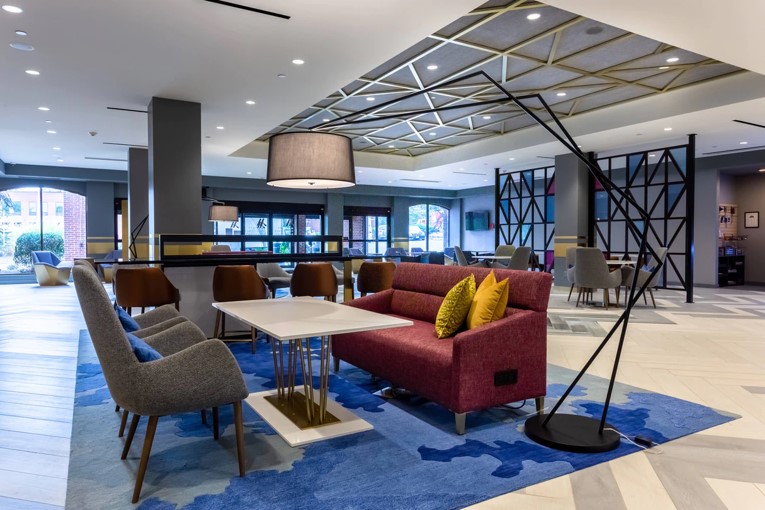
Keeping 2023 property improvement (plan) projects on target requires creative procurement, realistic scheduling, and wherever possible, going local
By George Rendell
After working in the hotel industry for more than 40 years and in design and construction for the past 22 years, I’ve learned to expect the vagaries of every hotel renovation project. But the industry has moved into a new, even more challenging era when it comes to renovation.
Higher guest expectations, elevated brand requirements, labor issues and supply-chain challenges have changed the way we budget and undertake every new project. Brand proliferation alone demands a far greater understanding of the look and feel of many more types of hotel offerings. The requirements for various lifestyle brands, soft brands and the more traditional limited and full-service brands have all added a new level of complexity to renovation projects that is clearly part of the new equation.
Guests desire all the comforts of home when they travel, especially when it comes to digital connectivity. They demand excellent high-speed connections, so brands are incorporating ever-increasing Wi-Fi standards in their PIPs. Hilton’s Connected Room platform, for example, enables guests to control everything from digital keys to room environment settings and in-room entertainment through their smartphone while also optimizing backend operations. Marriott and Accor have initiated similar efforts.
Digital nomads, the term used to describe guests who are no longer tethered to a physical office and can work remotely, is an offshoot of the pandemic that appears to be sticking around. These guests often check into our hotels for a week or more and, in some cases, are helping to offset the declines from corporate business travelers. Satisfying their demands to use our hotels as “live-in offices” has become part of the renovation mix as well.
Equipping high-speed guestrooms can be pricey. Today, it requires Category 6 cabling, which in some properties can mean complicated retrofits on hotels that were built before these standards evolved. Digital upgrades are now part of every scheduled room refresh we undertake, whether it’s a market-driven repositioning of an existing asset or part of the PIP when a property changes ownership.
Design initiatives such as bespoke, earthy and experiential are becoming just as important as a comfortable bed, a good TV and bathrooms without tubs. Many guests want a hotel experience that speaks to the local area, with interiors that reflect the local vernacular. Purchasing from local suppliers, for example, can provide a hometown touch while lowering shipping requirements. But the practice adds complexity to both the design and the purchasing functions and need to be factored in.
With the ongoing labor shortage contributing to supply-chain snags, the cost and lead time for items ranging from computer chips to glass and aluminum has doubled in some locations. Based on what I’m hearing from purchasing agents, this trend is expected to continue beyond 2024. To help keep lead times and shipping costs manageable, North American hotel brand requirements are shifting away from suppliers in China and Southeast Asia in favor of North American suppliers. We need to shift our purchasing practices as well to meet that trend.
Thankfully, the pandemic-related rise in shipping container prices has largely subsided, but since purchasing agents are now ordering items earlier and storing them longer, warehousing costs have increased substantially.
Our hotel renovation project partners are also busy. Architects, designers, general contractors and MEP consultants are all working further out. Which means that if you have a specific design team or contractor in mind, you must ensure a spot on their radar by informing them well in advance that you want their bid on an upcoming project and provide a timeframe.
Durable Surfaces, Safer Showers
Along with procurement challenges, the pandemic has brought heightened guest concerns for “perceived cleanliness.” Accordingly, many brand’s design specs now require quartz and other engineered solid surface materials for bathroom surfaces. These materials are far more durable than natural stone, don’t etch or develop moisture rings as easily and are available in a variety of styles that can mimic natural stone—even Carrara marble.
For flooring, luxury vinyl tile (LVT) remains a popular alternative to carpet since many guests perceive it to be easier to keep clean. Room renovations which include this switch to LVT from carpet often require fresh acoustical assessments, in order to mitigate the loss of the sound-dampening qualities of that carpet. It’s another new wrinkle in a basic room refresh project we must now plan for.
Guests increasingly want showers, not bathtubs, also partly due to cleanliness concerns. This trend began before the pandemic but is now showing up in most brand standards. Because bathtubs also carry higher slip-and-fall risk than showers, owners have some incentive to remove bathtubs. Despite the upside, it’s still an expensive conversion, often costing $8,000 to $10,000 per room. Any renovation project that involves bathtub-to-shower conversions carries a substantial cost per key.
Suppliers have stepped up their shower product offerings that help keep costs down, such as new types of low-profile shower pans, linear drains and shower panels to replace more expensive tiled shower walls. The options also give interior designers additional flexibility with the overall bathroom look and feel.
A typical PIP project today includes renovating guestrooms, public spaces and meeting spaces as well as exchanging an existing packaged terminal air conditioner (PTAC) system for more efficient variant refrigerant flow (VRF) equipment. Schedules must be well coordinated and realistic in order to have the work done simultaneously once a floor is taken out of service. Like most owner/operators, we renovate during slower business periods to minimize revenue displacement.
Each property has its own challenges to making it all work smoothly. Limited-service brand renovations are often easier given the cookie-cutter aspects of the brand itself. Soft brand assets are another story. These properties are, by designation, unique and are often historically protected. Opening up walls in a centuries old hotel building adds a new layer of complexity to these PIP projects, which are increasingly becoming part of our mix. That will only increase in our new, highly segmented hotel market.


